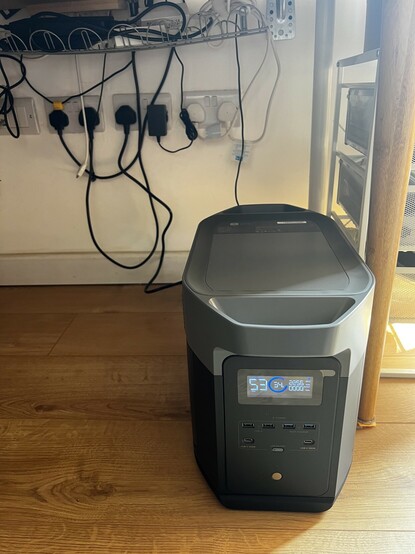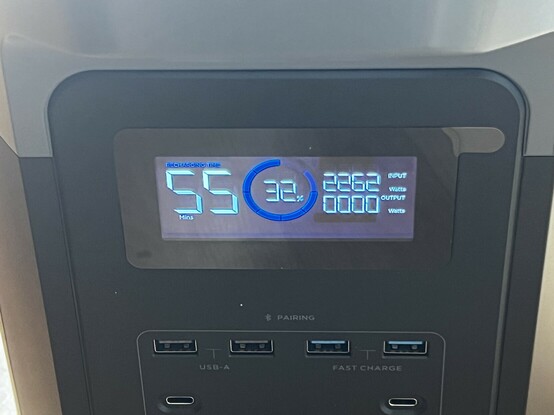Off-grid Office
I’ve been having something of a quandary lately. When we moved and kitted out a home office, it needed power. It just so happened that a 20A car charger circuit was perfectly positioned to provide it. So we stole the circuit to power the office sockets, while a couple of extra sockets and the lights were extended tentatively off the kitchen spur.
But that means the car charger is now out of service. That’s a problem. I’m on the cusp of finally- after far too many years- getting a driving license and forging out into the wide world. Well, being a dad taxi anyway. I would like an electric car, but granny-charging from a plug in the office might not be ideal. In fact it would be rather less than ideal, given my home to real-actual-office commute is some 120 miles each way.
“You could get a second circuit installed for the car charger,” you might venture. Well yes, but no. When we first moved in, it was readily apparent that wiring anything from the inside of the house- mains power enters in the living-room under-stairs cupboard against a party wall – to the outside – a clear shot across the living room – would be tricky. The car charger had been installed by means of ugly conduit running around the living room ceiling. Since we had the upstairs carpets up, we figured it could do with fixing. It was a herculean effort to remove this cable and pull it through the ceiling. It took hours. that’s one adventure we don’t want to repeat.
So, faced with the prospect of either hours of painstaking cable routing or an unsightly conduit, the option of a new charger seems pretty untenable.
So, what then?
Enter EcoFlow. A bolt out of the blue and a company I had not previously heard of. A company that sells complete, install-yourself, battery solar solutions with 800W generation capacity and 2kWh storage. That sounds awfully like the sort of kit that might solve my problem by simply avoiding it altogether. Granted this solution is rather more expensive than a second charger, it’s considerably less hassle and has the potential to evaporate my home office energy costs.
Juicing up the EcoFlow DELTA 2 Max. It’s a 2048Wh monster! My office currently runs from a 20A car charging circuit, disabling the charger, I’m hoping to switch to solar but first I’m testing this hulk! Maybe I can load shift?
So here I am, with a hulking great EcoFlow DELTA 2 Max sat next to me, waiting for the solar generation, and getting a feel for how feasible an off-grid office might be.
So, what’s the plan?
The general idea – assuming I can make it happen – is to completely isolate the office sockets from the household power supply. This is, at least in theory, trivially easy since they’re tied to the old car-charger supply inside a little junction box.
I’m planning to take this isolated loop of sockets- five double sockets if anyone’s counting – and stick a fused plug on the end. Yeah. You heard me. I’m going to turn the office sockets into a glorified extension cord. Cool your jets, though, it’s all laptops and low-power devices in here. I’m sure nothing could possibly go wrong!
Now, if you were following along above you might have caught the kitchen spur in the mix. Yes, technically a couple of double sockets and – if I remember correctly (I’ve got photos of the wiring somewhere, I should probably make a diagram) – the office lights are powered from a spur off the kitchen. This was part of a backup plan where I could still power a WiFi router, switch and lights while having – perhaps by means of a big, chunky switch – the office supply switched back over to the car charger at night.
This does, technically, mean the office is not totally off-grid, but I can live with that. I’m solving a problem here, not making an ideological stand.
Since the EcoFlow DELTA 2 Max can charge from A/C, and its charging rate can be adjusted anywhere from 200W to 2400W I can set a kitchen-spur-friendly charge rate as a failover without running the risk of releasing magic smoke into my walls. It’s also possible to set what times the DELTA 2 Max will charge, so there’s a potential for switching to an electric-car friendly electricity tariff and sharing that six hour charging window with both car and battery (if needed.)
The final piece of the puzzle, of course, is generation. My initial tests show that the DELTA 2 Max can run my workstation for somewhere around 14 hours. More than enough for a productive day. This could then be slow-charged overnight, accomplishing what’s known as load shifting by storing cheap energy from off-peak times and giving it back to me during the day. Of course the astute among you might notice that load shifting to 9-5:30 is not super effective, since peak times fall when everyone gets home from work and fires up their ovens and washing machines. A quick glance at agileprices.co.uk reveals this window is somewhere around 16:00 to 18:00.
So solar generation seems like the obvious answer. While peak energy usage doesn’t correspond with my daytime office use, the sun – at least in the summer months – makes an effort.
Right now my workstation- an Alienware m15 r3 laptop running Pop!_OS, an OWC Thunderbolt 3 Dock, a Streamplify USB hub, two 27″ LG monitors running in low brightness and various peripherals- is pulling around 100W to 120W. This doesn’t include the various other setups I might deploy for testing or working on Pi-stuff, so my usage could be double or triple that at times. My laptop is also being powered exclusively over USB Type-C via the Thunderbolt dock, forcing it to maintain a low performance state and rely on its internal battery to make up for any shortfall.
Stats, or it didn’t happen!
It seems an almost foregone conclusion that any geek of my caliber must be willing to share a blow-by-blow account of solar generation. I think gathering and analysis data – something that I did in a professional capacity many, many moons ago with Microsoft OLAP – may be crucial to understanding how realistic a fully off-grid office might be.
I’ve already tentatively explored how easy it is to extract data from EcoFlow’s DELTA 2 and incorporate it into my InfluxDB and Grafana powered weather monitoring setup. It turns out that, behind the scenes, EcoFlow simply use MQTT. MQTT is a bog standard system for sharing messages between devices that has libraries in multiple languages; crucially one for Python that I’m already familiar with. Logging into EcoFlow’s MQTT server with your device’s credentials isn’t trivial, but it’s not difficult either. I was able to hack together a proof of concept by twisting `ecoflow_exporter.py` to my needs.
EcoFlow’s device communication protocol is thoroughly undocumented and at least a little bit cryptic, but it’s not insurmountable and it’s easy to connect to MQTT, subscribe to the control channels, and simply “sniff” messages sent from/to their official app in order to understand how to both gather data and control the device.
I have a Pimoroni Weather HAT (of course I do) and accompanying weather station already deployed, and I’ve been playing with BLE communication across our range of Pico W-powered Enviro sensors so that I can get an outdoor light sensor (though isn’t a solar panel effectively just a big light sensor?) operational.
All of this data should, hopefully, paint a picture of how feasible solar generation and off-grid power works for my office. I’m particularly interested in how this changes throughout the year, and with the temperamental nature of British weather probably from week-to-week too. Right now, though, the sun is shining bright and I’m itching to get the solar system installed.
Stay tuned!
Comments, suggestions, tell me I’m going to fry myself? – let me know on Mastodon via this thread!

